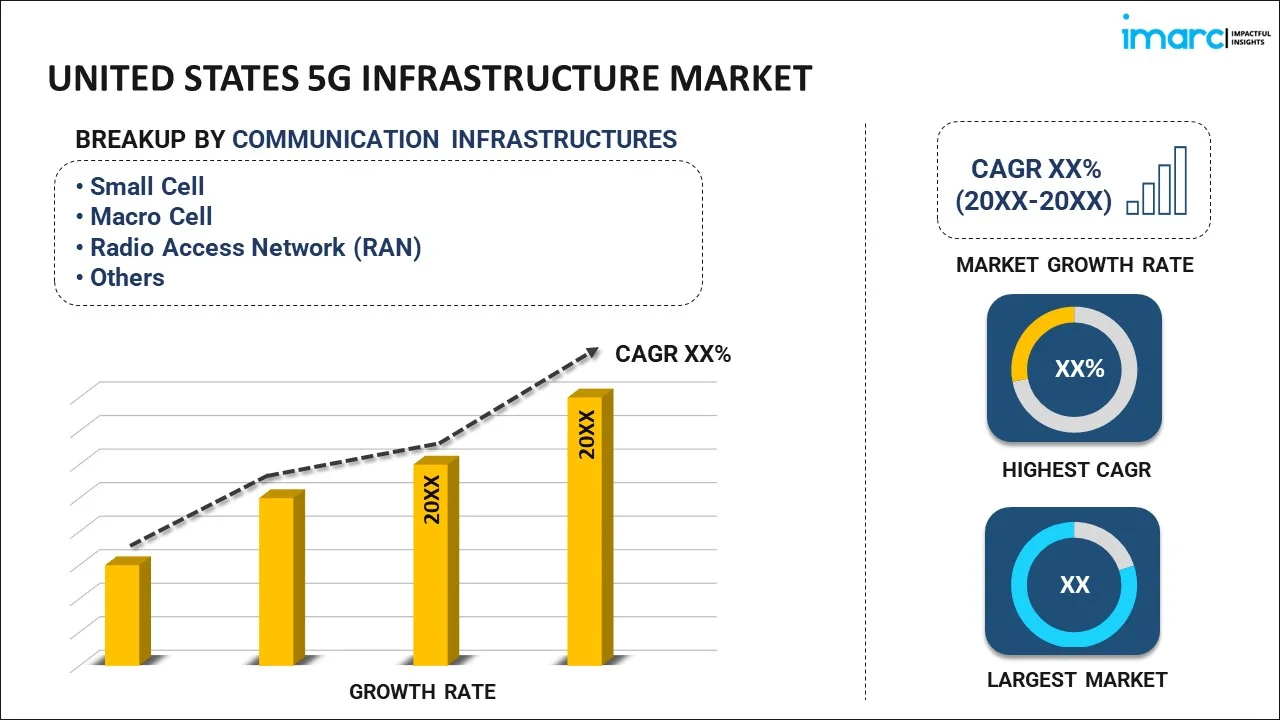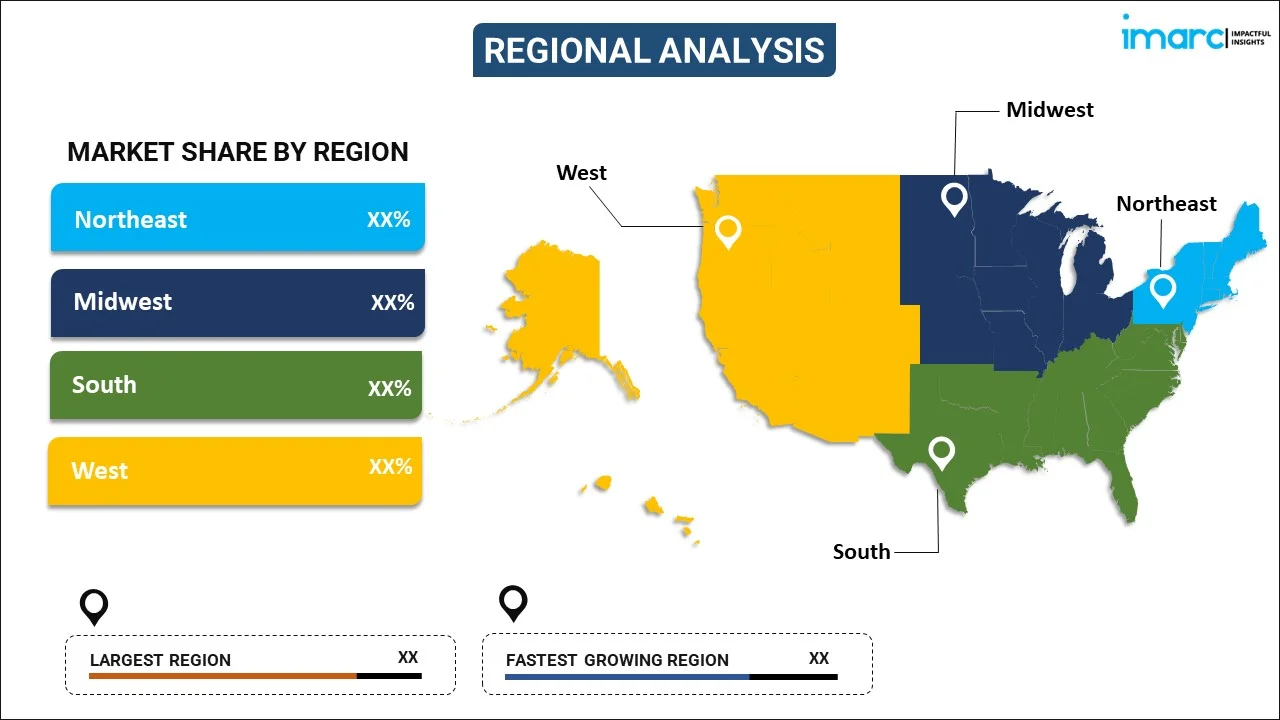
United States 5G Infrastructure Market Report by Communication Infrastructure (Small Cell, Macro Cell, Radio Access Network (RAN), and Others), Network Technology (Software-Defined Networking, Network Function Virtualization, and Others), Network Architecture (Standalone, Non-Standalone), Frequency (Sub-6 Ghz, Above 6 Ghz), End User (Automotive, Energy and Utilities, Healthcare, Home User, and Others), and Region 2024-2032
Market Overview:
United States 5G infrastructure market size is projected to exhibit a growth rate (CAGR) of 42.60% during 2024-2032. The growing availability and efficient utilization of the radio spectrum, rising demand for high-speed internet and data services among people and businesses, and increasing employment in the healthcare industry to offer remote consultations and diagnoses represent some of the key factors driving the market.
|
Report Attribute
|
Key Statistics
|
|---|---|
|
Base Year
|
2023 |
|
Forecast Years
|
2024-2032
|
|
Historical Years
|
2018-2023
|
| Market Growth Rate (2024-2032) | 42.60% |
5G infrastructure encompasses a network of equipment, protocols, and technologies designed to support this new generation of wireless communication. It consists of enhanced mobile broadband (eMBB), ultra-reliable low-latency communications (URLLC), and massive machine-type communications (mMTC). It varies from standalone (SA) systems, which operate on a completely new network, to non-standalone (NSA) networks that leverage existing 4G infrastructure. It allows users to enjoy faster and more reliable connections, enabling seamless streaming, online gaming, and improved telecommuting experiences. It is instrumental in expanding the Internet of things (IoT) ecosystem, empowering billions of devices to communicate efficiently, ranging from smart appliances to industrial sensors. It is designed to be more energy-efficient than its predecessors, reducing the environmental footprint of wireless communication. It can handle a massive number of devices simultaneously, ensuring that crowded venues and smart cities can maintain seamless connectivity. Its uses are diverse, ranging from enhancing personal communication and entertainment to transforming sectors like healthcare, transportation, and manufacturing through improved connectivity and data processing capabilities.
United States 5G Infrastructure Market Trends:
At present, the rising availability and efficient utilization of radio spectrum, which is crucial for the deployment of 5G networks, represents one of the key factors impelling the market growth in the United States. Additionally, the growing technological innovations in massive MIMO technology, beamforming, and small cell deployments for enhancing network capacity and coverage are offering a favorable market outlook. The advancements in network slicing and edge computing are enabling more efficient data processing and management, facilitating the deployment of 5G in diverse sectors. Besides this, increasing collaborations between telecom operators, technology providers, and equipment manufacturers are leading to shared knowledge, reduced costs, and accelerated deployment of 5G networks. Moreover, the rising demand for high-speed internet and data services among people and businesses is bolstering the market growth in the country. This is further amplified by the increase in remote work, online education, streaming services, and the proliferation of IoT devices. The need for reliable, high-capacity networks is more pronounced than ever, making the deployment of 5G networks a necessity. In addition, the growing employment of 5G in telecom companies to provide users with faster, more reliable mobile broadband services is positively influencing the market. This upgrade from 4G to 5G offers significantly higher speeds and lower latency, enhancing the user experience in streaming, gaming, and other data-intensive applications. Furthermore, the increasing utilization of 5G technology in the healthcare industry to offer remote consultations and diagnoses is strengthening the market growth in the country. It also facilitates the real-time transmission of large imaging files, improves the reliability of remote patient monitoring devices, and supports the advent of AI-driven diagnostic and treatment tools.
United States 5G Infrastructure Market Segmentation:
IMARC Group provides an analysis of the key trends in each segment of the market, along with forecasts at the country level for 2024-2032. Our report has categorized the market based on communication infrastructure, network technology, network architecture, frequency, and end user.
Communication Infrastructure Insights:

- Small Cell
- Macro Cell
- Radio Access Network (RAN)
- Others
The report has provided a detailed breakup and analysis of the market based on the communication infrastructure. This includes small cell, macro cell, radio access network (RAN), and others.
Network Technology Insights:
- Software-Defined Networking
- Network Function Virtualization
- Others
A detailed breakup and analysis of the market based on the network technology have also been provided in the report. This includes software-defined networking, network function virtualization, and others.
Network Architecture Insights:
- Standalone
- Non-Standalone
The report has provided a detailed breakup and analysis of the market based on the network architecture. This includes standalone and non-standalone.
Frequency Insights:
- Sub-6 Ghz
- Above 6 Ghz
A detailed breakup and analysis of the market based on the frequency have also been provided in the report. This includes sub-6 Ghz and above 6 Ghz.
End User Insights:
- Automotive
- Energy and Utilities
- Healthcare
- Home User
- Others
The report has provided a detailed breakup and analysis of the market based on the end user. This includes automotive, energy and utilities, healthcare, home user, and others.
Regional Insights:

- Northeast
- Midwest
- South
- West
The report has also provided a comprehensive analysis of all the major regional markets, which include Northeast, Midwest, South, and West.
Competitive Landscape:
The market research report has also provided a comprehensive analysis of the competitive landscape. Competitive analysis such as market structure, key player positioning, top winning strategies, competitive dashboard, and company evaluation quadrant has been covered in the report. Also, detailed profiles of all major companies have been provided.
United States 5G Infrastructure Market Report Coverage:
| Report Features | Details |
|---|---|
| Base Year of the Analysis | 2023 |
| Historical Period | 2018-2023 |
| Forecast Period | 2024-2032 |
| Units | US$ Million |
| Scope of the Report | Exploration of Historical and Forecast Trends, Industry Catalysts and Challenges, Segment-Wise Historical and Predictive Market Assessment:
|
| Communication Infrastructures Covered | Small Cell, Macro Cell, Radio Access Network (RAN), Others |
| Network Technologies Covered | Software-Defined Networking, Network Function Virtualization, Others |
| Network Architectures Covered | Standalone, Non-Standalone |
| Frequencies Covered | Sub-6 Ghz, Above 6 Ghz |
| End Users Covered | Automotive, Energy and Utilities, Healthcare, Home User, Others |
| Regions Covered | Northeast, Midwest, South, West |
| Customization Scope | 10% Free Customization |
| Report Price and Purchase Option | Single User License: US$ 3699 Five User License: US$ 4699 Corporate License: US$ 5699 |
|
Post-Sale Analyst Support |
10-12 Weeks |
| Delivery Format | PDF and Excel through Email (We can also provide the editable version of the report in PPT/Word format on special request) |
Key Questions Answered in This Report:
- How has the United States 5G infrastructure market performed so far and how will it perform in the coming years?
- What has been the impact of COVID-19 on the United States 5G infrastructure market?
- What is the breakup of the United States 5G infrastructure market on the basis of communication infrastructure?
- What is the breakup of the United States 5G infrastructure market on the basis of network technology?
- What is the breakup of the United States 5G infrastructure market on the basis of network architecture?
- What is the breakup of the United States 5G infrastructure market on the basis of frequency?
- What is the breakup of the United States 5G infrastructure market on the basis of end user?
- What are the various stages in the value chain of the United States 5G infrastructure market?
- What are the key driving factors and challenges in the United States 5G infrastructure?
- What is the structure of the United States 5G infrastructure market and who are the key players?
- What is the degree of competition in the United States 5G infrastructure market?
Key Benefits for Stakeholders:
- IMARC’s industry report offers a comprehensive quantitative analysis of various market segments, historical and current market trends, market forecasts, and dynamics of the United States 5G infrastructure market from 2018-2032.
- The research report provides the latest information on the market drivers, challenges, and opportunities in the United States 5G infrastructure market.
- Porter's five forces analysis assist stakeholders in assessing the impact of new entrants, competitive rivalry, supplier power, buyer power, and the threat of substitution. It helps stakeholders to analyze the level of competition within the United States 5G infrastructure industry and its attractiveness.
- Competitive landscape allows stakeholders to understand their competitive environment and provides an insight into the current positions of key players in the market.
Need more help?
- Speak to our experienced analysts for insights on the current market scenarios.
- Include additional segments and countries to customize the report as per your requirement.
- Gain an unparalleled competitive advantage in your domain by understanding how to utilize the report and positively impacting your operations and revenue.
- For further assistance, please connect with our analysts.
 Inquire Before Buying
Inquire Before Buying
 Speak to an Analyst
Speak to an Analyst
 Request Brochure
Request Brochure
 Request Customization
Request Customization




.webp)




.webp)












